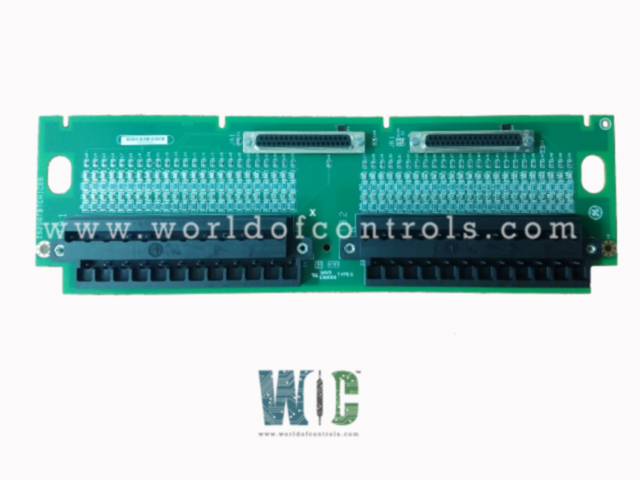SPECIFICATIONS
Part No.: IS200TBTCH1CCB
Manufacturer: General Electric
Country of Manufacture: United States of America (USA)
Size 26.04 cm high x 1.99 cm, wide x 18.73 cm, deep
Product Type: Thermocouple Input Terminal Board
Availability: In Stock
Series: Mark VIe
Functional Description
IS200TBTCH1CCB is a Thermocouple Input Terminal Board developed by GE. It is a part of Mark VIe control system. The terminal board is engineered to accept 24-type E, J, K, S, or T thermocouple inputs, providing versatility in temperature sensing across different industrial applications. Moreover, with the integration of PTCCH2 in Mark VIe, additional thermocouple types including B, N, and R can be accommodated, broadening the board's compatibility spectrum.
Features
- Wiring Configuration: Thermocouple inputs are wired to two barrier-type blocks situated on the terminal board, ensuring secure and reliable connections. This configuration enhances the integrity of temperature readings and minimizes the risk of signal interference or distortion.
- Communication Interface: The TBTC terminal board communicates with the I/O processor through DC-type connectors, facilitating seamless data transmission and integration within the control system architecture. This communication interface ensures efficient transfer of temperature data for real-time monitoring and control purposes.
- Variant Options:
- TBTCH1C (Simplex Applications): This variant features two DC-type connectors, suitable for simplex applications where a single control module suffices to meet operational needs.
- TBTCH1B (TMR Applications): Designed for Triple Modular Redundant (TMR) applications, this variant is equipped with six DC-type connectors, accommodating the redundancy requirements and ensuring system reliability in critical operational environments.
- Versatility and Integration: The TBTC terminal board seamlessly integrates into the Mark VIe system, providing a reliable and accurate solution for temperature sensing and monitoring tasks. Its compatibility with a wide range of thermocouple types, coupled with variant options catering to different application scenarios, underscores its versatility and adaptability to diverse industrial settings.
Installation
- Wiring Connection: Connect the thermocouple wires directly to the two I/O terminal blocks mounted on the terminal board. These removable blocks are securely held down with two screws, providing easy access for wiring. Each terminal block features 24 terminals, accommodating up to 12 AWG wires for robust connectivity. A shield terminal strip, attached to chassis ground, is positioned on the left side of each terminal block, enhancing system grounding and signal integrity.
- Connection in Mark VI Systems: For Mark VI systems, cable the J-type connectors to the I/O processors housed in the VME rack. Ensure proper cable routing and secure connections to facilitate seamless communication between the terminal board and the I/O processors.
- Connection in Mark VIe Systems: In Mark VIe systems, plug the I/O packs directly into the J-type connectors located on the terminal board. Depending on the level of redundancy required for the system, determine the number of cables or I/O packs needed for installation. Ensure proper alignment and secure insertion of the I/O packs into the J-type connectors to establish reliable connections.
- Verification and Testing: After installation, perform thorough verification and testing procedures to ensure proper functionality and integration of the terminal board with the control system. Check for continuity, proper wiring connections, and signal integrity to validate the accuracy of temperature readings and monitoring.
Operation
- Thermocouple Input Flexibility: The terminal board accommodates both grounded and ungrounded thermocouple inputs, providing versatility in temperature sensing configurations. Each of the 24 thermocouple inputs can be located up to 300 meters away from the turbine control panel, allowing for flexible installation options. The maximum two-way cable resistance for reliable signal transmission is limited to 450 ohm, ensuring accurate temperature readings over extended distances. Noise
- Suppression and Reference Devices: Equipped with high-frequency noise suppression capabilities, minimizing interference and ensuring clean signal acquisition for precise temperature monitoring. Additionally, two CJ reference devices are integrated into the terminal board, enhancing signal stability and accuracy across varying operating conditions.
- Analog-to-Digital Conversion and Linearization: The I/O processor, connected to the board, performs analog-to-digital conversion and linearization tasks for individual thermocouple types. This process ensures that raw temperature data from the thermocouple inputs are accurately digitized and linearized, providing reliable temperature measurements for further processing and analysis.
- Signal Processing and Integration: Upon conversion and linearization, temperature data from the thermocouple inputs are processed and integrated into the control system architecture. The processed temperature information is then utilized for real-time monitoring, control, and decision-making processes within the turbine control system.
- System Compatibility and Reliability: It is designed to seamlessly integrate into the overall control system framework, providing critical temperature sensing capabilities for turbine operation. Its robust design and reliable performance contribute to the overall reliability and efficiency of the control system, ensuring smooth operation and optimal turbine performance.
The WOC team is always available to help you with your Mark VIe requirements. For more information, please contact WOC.
Frequently Asked Questions
What is IS200TBTCH1CCB?
It is a Thermocouple Input Terminal Board developed by GE under the Mark VIe series.
What are CJ signals, and how are they utilized within the system?
CJ signals, also known as cold junction compensation signals, play a crucial role in compensating for temperature variations at the junction of thermocouple wires. They are utilized to ensure accurate temperature readings by accounting for changes in ambient temperature conditions.
How are CJ signals monitored within the system?
CJ signals are processed and monitored within the signal space of the system. Typically, the average of the two CJ signals is used for monitoring purposes. Any deviation from acceptable limits configured within the system triggers a logic signal, indicating a potential issue with temperature compensation.
What are the acceptable limits configured for CJ signals?
Acceptable limits for CJ signals are pre-configured within the system based on operational requirements and temperature calibration standards. Deviations beyond these limits can indicate inaccuracies in temperature compensation and may warrant further investigation or adjustment.
